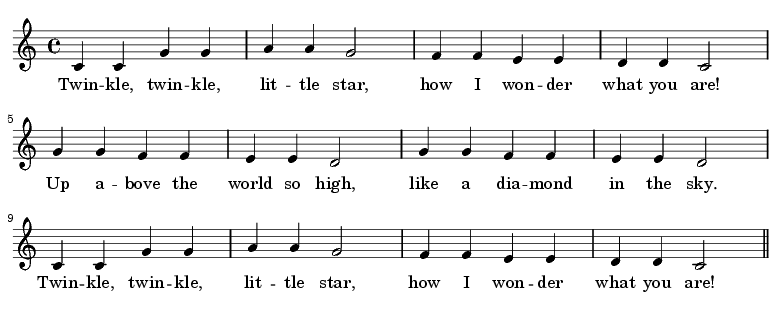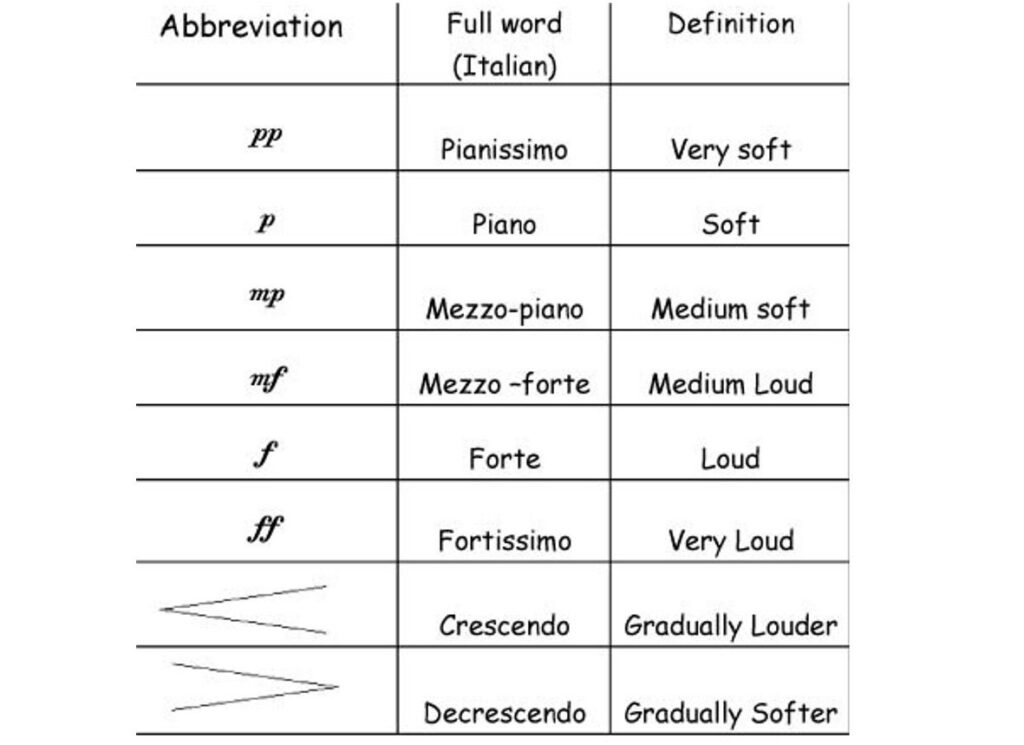Music is simply the art of producing sounds in a harmonical way with the help of instrumental sounds or vocal. Music is inexplicable, to be honest. It is limitless and maybe the most beautiful thing in the universe. However, we can still define terms related to music. Here are all you need to know about music vocabulary.
Introduction to Music Vocabulary
I would like to define music vocabulary elements with a simple definition that states:
Music is a sound and silence organized through time to convey idea or feelings.
# Sound & Silence
- Timbre: Unique characteristics of sound, also known as tone color.
- Pitch: Determines how high or low the note is, also refers to the quality of the note.
# Organized through time
- Duration (beat, rhythm, meter)
- Form (same vs. different, sections, phrases)
- Texture
# To convey ideas or feelings
- Tempo (Fast/Slow)
- Dynamics (Loud/ soft)
- Articulation (style-smooth, accented, short, etc.)
In addition to basic definition, here is the elaboration of each term. To make it easy to remember, I have given a short form MR. Pat Dish where M= Melody, R=Rhythm, P=Pitch, a=articulation, t= Tempo/Texture/Tonality/Timbre, D=dynamics, i=instrumentation, s= structure/silence and h=harmony. Let’s uncover them one by one!
# Music Elements: MR.Pat Dish
1. Melody

It is an important musical element. You can hear billions of melodies in the world. If you are singing a “Twinkle Twinkle Little Star”, then it’s a melody. When you sing a “Happy Birthday “to your niece, it’s a melody. From infectious guitar groove to catchy chorus, they are the part of the music or song that you are most likely to remember. Found in all genres, they exist all over the planet.
2. Rhythm
Rhythm is another crucial term in music vocabulary. Theoretically, it is the recurrence of silences and notes in time. Guitar, piano, bass, drums, are known as rhythm providing instrument. It is important in music because they give a composite structure to music.
3. Pitch
It refers to how high or low a sound is. In other words, it is a frequency of a note. Higher the frequency, the higher the pitch is and vice versa. Measured in Hertz, you may have heard people commenting songs calling “a perfect pitch”.
Note: The meaning of pitch in commercial songwriting is quite different. Pitching a song means playing it for an artist, a publisher with aim of selling the song. People pitching songs for a living is called a song plugger.
4. Articulation
Moving towards our music vocabulary, we have articulation, which refers to the performance technique on how someone plays a certain note in a certain way to accelerate mood. It’s similar when speaking, you emphasize certain words or phrases. Likewise, combinations of different articulations help to communicate stories with different feeling and mood behind it.
5.Tempo/Texture/ Tonality /Timbre
5.1 Tempo
The tempo is the speed of the beat and determines if the song is fast, moderate, or slow. The Italian word for faster is Accelerando, and for slower its Decelerando. But, if you are listening to more modern music like dance, rock, and pop, BPM: Beats Per Minute comes to play.
5.2 Texture
Texture is another important element of music vocabulary. It is several parts playing and can be thin, thick, dense, light, and heavy. As every physical thing has texture, so does the music. Since music does not have the physical form, sound characterize its texture. If music has several layers of instruments and many harmonies and melodies played simultaneously, it can be termed as thick texture. It can be further defined by the term Monophonic. Simple children’s songs like “Happy Birthday “and “Alphabet Song” are monophonic. Johann Sebastian Bach’s Cello Suite No. 1 is another example.
Whereas most of the western music and pop songs have a homophonic texture, where multiple notes are played together. “Perfect” of Ed Sheeran is a great example of a homophonic texture.
The third type of musical texture is polyphonic where independent multiple melodies occur at the same time. Famous in the renaissance, « Fugue No. 17 in A-Flat Major » is a classic example of polyphonic texture.
5.3 Tonality
Tone explains a lot in the Music vocabulary. As ears need to recognize changes, your brain has to differentiate between major and minor. It is about a key signature. If tonality is in major, it is a happy sound. However, the minor scale consists of a sad sound.
5.4 Timbre
Another terminology in the music fundament is Timbre. It is a quality or character of musical sound. For instance, if you hear your father talking in another room, you will still be able to recognize him with his sound and it is because of his voice timbre. Similarly, in the sound, you can distinguish B note played on a trumpet to a B note from the guitar. Some of the words that you can use to describe timber are clean, thin, thick, dull, rich, piercing, nasal, …
6. Dynamics
Dynamics is an easy element to understand. It is also volume and to simplify, we can term it as loud and soft.

7. Instrumentation (Orchestration)
You need to recognize the instruments and the way they are played. Instrumentation is an art of combining different instruments in any form of musical composition used in jazz bands, chamber groups, symphonic bands, and so on. Western music comprises an instrument like brass, strings, woodwinds, and percussions. Then again, we have instrumentation types like vocal, electronic, keyboard, percussion, muting, string technique, and wind technique. If you want to learn more about instrumentation, here is a good read from Music vocabulary of Britannica.
8. Structure (form) / Style (genre) / Silence
8.1 Structure
Form or structure is the shape, structure, or organization of music.
8.2 Style / Genre
The style of music is huge topic to cover in a single article. Style and genre are quite a tricky one. Genre is a character and style is a type within the genre. Style can vary. For example, Classical has styles like Symphony, Concerto, Baroque, Classical, Romantic, and Opera.
# Some poular music genres
- Blues
It is the combination of Western and African music. Blues song expresses stories of heartbreak and also about being in love, with a mixture of fun elements. They are really good to dance with up-tempo. For later blues, try Muddy Waters, Billie Holiday. Here are some bold tunes to give you some introduction to this genre.
- Jazz
When African American musicians only played blues, some played classical music with European harmony. It was when Jazz was born. New styles evolved during the 1930s which was played with jazz orchestras with rhythms sections of piano, guitar, double bass, and drums. Explore these smooth, sophisticated, and confident jazz beds from BAM Music.
- Rock & Roll
A new genre was evolved in 1950 and was played on double bass, electric guitar, guitars, and drums. As name indicates, Rock & Roll is great to dance with fun lyrics and popular among teenagers. The king of rock and roll is Elvis Presley.
Similarly, when rock music evolved, there came a Rock Music. Country Music became popular around the 60s, then came melodic Rhythm and Blues ,”Soul Music“. Later, funk rhythms were initiated and a new style of Dance music rose. In the 70s, Hip Hop developed and is one of the popular music styles in the world.
8.3 Silence
Silence is not just a canvas where we paint music. There is an important role of silence in music. For instance, utilizing silence technique in jazz is dominant. A composer should know when to fill a void, or when to play notes.
The length of silence, the distance between periods of silence, and the magnitude of silence all make an effect on the listener.
9. Harmony
Harmony is another important element in music vocabulary. It is the sound of two or more notes heard simultaneously and supports the melody. It is the product produced when the individual voice group together forming a unified whole. For instance, in an orchestra, the violinist is playing one note, a flute player is playing another note, or a trombonist playing his note. But all this individual part played and we hear together a harmony. Composer scripts the harmony often.
Conclusion
There is a whole universe of new melodies to be created, silences to be echoed, harmony to be synchronized, feelings to be expressed and new genres to be recreated and created. This music vocabulary might be your first step in the musical journey. Music terminologies are vast and the more you dive into it, the more ignorant you might feel. Keep learning & keep Moving.
At BAM Music, we bring together artists from all over the world, with their musical creation in our music library and further help creators power their content than the use of copyright-free music and Royalty Free Music. Keep connecting for more music-related content.
Happy Listening & Happy creating!







